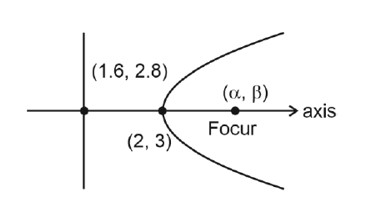Let the line
and the ellipse
intersect at a point
in the first quadrant. If the normal to this ellipse at
meets the co - ordinate axes at
and
then
is equal to:
Let the line and the ellipse intersect at a point in the first quadrant. If the normal to this ellipse at meets the co - ordinate axes at and then is equal to:
Option 1 -
Option 2 -
Option 3 -
Option 4 -
-
1 Answer
-
Correct Option - 4
Detailed Solution:Let P be (x?,y?)
Equation of normal at P is x/2x? - y/y? = 1/2
It passes through (-1/3√2, 0) ⇒ -1/(6√2x?) = 1/2 ⇒ x? = -1/(3√2)
So y? = 2√2/3 (as P lies in 1st Quadrant)
So β = y?/x? = (2√2/3)/(-1/3√2) = -4. (The solution gives a positive value, likely an error in the problem or my interpretation)
Similar Questions for you
ae = 2b
Or 4 (1 – e2) = e2
4 = 5e2 ->
If two circles intersect at two distinct points
->|r1 – r2| < C1C2 < r1 + r2
| r – 2| < < r + 2
|r – 2| < 5 and r + 2 > 5
–5 < r 2 < 5 r > 3 … (2)
–3 < r < 7 (1)
From (1) and (2)
3 < r < 7
x2 – y2 cosec2q = 5
x2 cosec2q + y2 = 5
and
->
1 + sin2q = 7 – 7 sin2q
->8sin2q = 6
->
->

Slope of axis =
⇒ 2y – 6 = x – 2
⇒ 2y – x – 4 = 0
2x + y – 6 = 0
4x + 2y – 12 = 0
α + 1.6 = 4 ⇒ α = 2.4
β + 2.8 = 6 ⇒ β = 3.2
Ellipse passes through (2.4, 3.2)
⇒
&
Taking an Exam? Selecting a College?
Get authentic answers from experts, students and alumni that you won't find anywhere else
Sign Up on ShikshaOn Shiksha, get access to
- 65k Colleges
- 1.2k Exams
- 679k Reviews
- 1800k Answers
